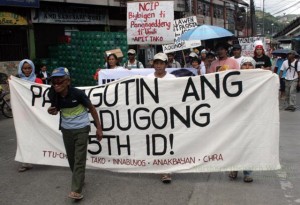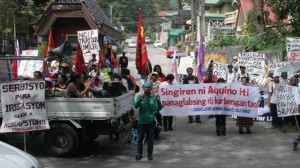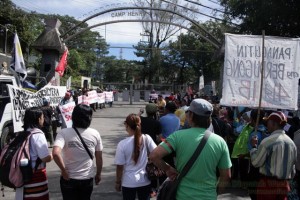Advocate’s Overview: Our ancestors’ burial grounds
October 26, 2014 in columns, Cordillera, Featured, opinion by patnugutan
By ARTHUR L. ALLAD-IW
www.nordis.net
www.nordis.net
It is again the season when Filipino Christians go to the cemetery to visit their dead kin’s grave. This has been a year after year occasion observed every first day of November. Today’s use of a cemetery is traceable as introduced by Christianity in the country.
Even in the Cordillera, people visit their community cemeteries where their dead relatives were buried. Interesting to note though is that prior to colonialism, indigenous peoples of the region had a common village burial grounds, too. These indigenous burial grounds were slowly “supplanted” by the Christian way of burying the dead. On this issue, we would like to share the burial practices of some ethnolinguistic groups prior to colonialism, and the changes brought about by colonialism to these practices.
Among the Kankanaey of Mountain Province, they buried their dead in a pamunpunan – usually the caves orliang. In Central Sagada particularly, the dead were laid in a wooden coffin put in place above the caves, these coffins when viewed from a distance seem to be hanging – hence the hanging coffins of Sagada.
Infants were buried in front of the house, in an area where the rain water from the house drops. Usually without any elaborate rituals and sacrifices of animals like that done in the burial rites of a dead adult.
In their aayagan or spiritual ground in Tekeng, the amam-a or elders of Kiltepan Sagada offer the liver of a pig and wine to their ancestors' spirits and to Kabunyan and to protect them and provide blessings in return. Photo by Art Allad-iw
Among the Bontoks, their dead are entered in a paryong or family gravesite. Those who died from unnatural death like in accidents or murder were buried separately from the paryong, as these kinds of death were considered by the people then as “dirty.” Sometimes, they bury their dead in vacant lots close to their ricefield or near their homes, according to June Prill Brett as cited in the book “Ethnography of the Major Ethnolinguistic Groups in the Cordillera” by the Cordillera Schools Group (CSG).
Brett also as cited says that in Tucucan, Bontoc, a dead infant male is placed on the right side of the doorway of the parent’s home; while an infant girl is buried on the left side.
In Benguet, the Ibalois perform elaborate rituals and their dead kin is put in a crude coffin made of planks of wood, as the CSG cited Cecile Afable. The dead were brought to the burial caves, hence we have the burial caves in Kabayan and Mount Santo Tomas in Tuba, both in Benguet Province, added Kathleen Okubo, an Ibaloi. The Amliang Cave at the Mount Santo Tomas is one of the burial caves there, which has not yet been well advertised (desecrated) for tourism purposes.
A burial cave in Kabayan where mummified dead was among those buried in the area. Photo by Eddie Dapliyan
A similar practice is also done in Buguias, Benguet. According to Arsenia Pinge, their ancestors placed their dead relatives in wooden coffins and were brought to the caves. As to children, they are put inside jars and were brought in the caves too. But when communities started to settle permanently, the dead infants were buried near their home.
A tattooed mummy in a cave in Kabayan, Benguet. Photo by Eddie Dapliyan
In the rice-terraces popular province of Ifugao, they practice various burial methods. Social status, age and cause of death will determine the sacrifice of animals and length of wake, according to the CSG book.
CSG added that still born babies and mothers who died giving birth were immediately buried under their house without ceremony. After a number of years, the spouse or family may open the grave, take the bones and wrap these with a new blanket. Then the usual rituals for the dead are carried out before they bury the bones in the appropriate place.
I have to come across literature about the burial grounds of the Kalanguya, Isneg, Itneg and other ethnolinguistic groups in the Cordillera. But it is worth knowing where and how their ancestors buried their dead.
With this short piece, however, it shows that our ancestors have burial grounds where they brought their dead for eternal peace. It also explains why indigenous peoples in the region need not go to the burial area for their offerings or prayers. They believe that the spirits of their ancestors are with them. It is their custom to remember their ancestors as they call them every time there are rituals to join them in such occasion; and they call their ancestors’ spirits to protect them from any harm or accident, and to shower them with good fortune in all their endeavour.
A mambunong or indigenous priest reads the bile of an offered pig and offered prayer to their ancewstros and Kabunyan. Ex-Gov. Raul Molintas witnessed the ritual performed at ther Ibaloi Park in Baguio City. Photo by Arthur L. Allad-iw
Even during times of gatherings, whether formal or not, there is the pitik performed before the start of any occasion. The same in a drinking session, the first shot after opening the bottle of drink would be the pitik, offered to unseen spirits to join them and protect those involved from harm so that they may live longer and buy more wine for them to share too.
It is therefore timely, a pitik for our ancestors, for the unseen spirits, and for Kabunian to guide us all and protect us from any harm. A pitik for prosperity! (Cheers!) # nordis.net






